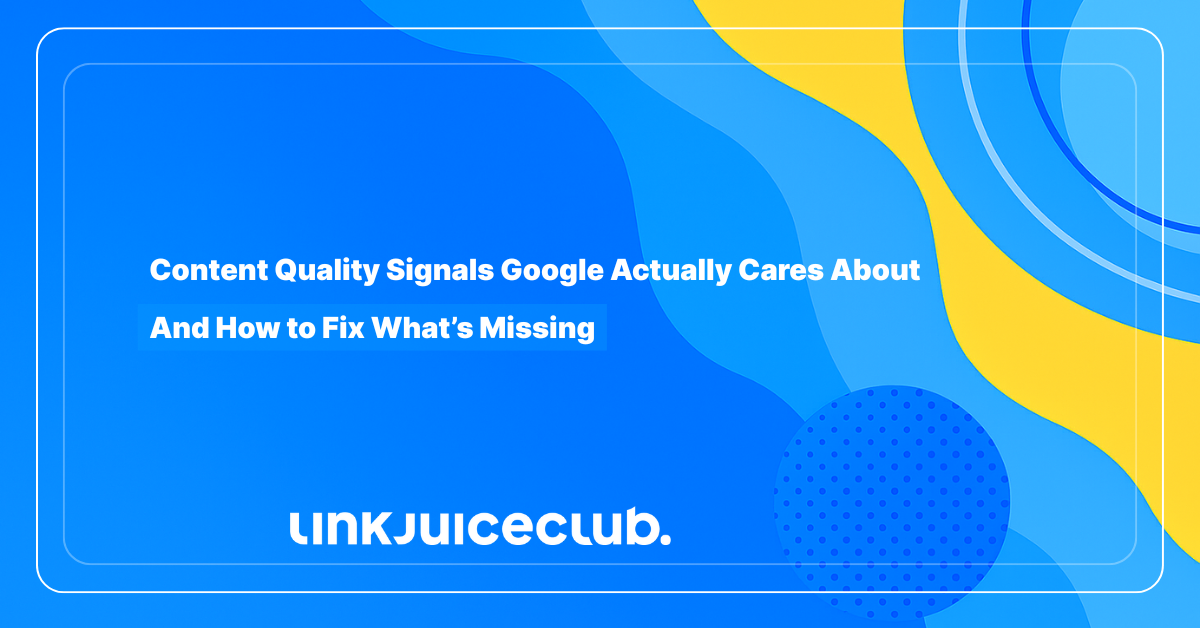
Content Quality Signals Google Actually Cares About — And How to Fix What’s Missing
When it comes to content quality, Google isn’t just skimming the surface — it’s reading between the lines. Ever since the Panda algorithm reshaped the SEO landscape back in 2011, the rulebook for what counts as “high quality” has only gotten tougher — and smarter.
Gone are the days when a few well-placed keywords could fool the system. Today, Google’s judgment is powered by a tapestry of machine learning, user signals, and trust metrics. The 2022 rollout of the Helpful Content Update (HCU) brought that into sharp focus — and plenty of websites felt the sting.
This wasn’t just another tweak. It was a reckoning. Many sites lost visibility overnight, flagged for content that didn’t serve real users, lacked depth, or echoed what was already said a thousand times.

Since then, the HCU has evolved — and so must your approach. SEOs and creators alike are now laser-focused on making sure every page earns its spot in the index.
In this guide, you’ll get:
- ✅ A breakdown of what actually counts as poor content today
- 🛠️ Step-by-step audits to surface weak spots
- 🚀 Fixes that make your pages Google-friendly and user-loved
Let’s dive into the signals Google cares about — and how to turn shaky content into solid gold.
What Google Really Looks For When It Judges Your Content
Let’s clear one thing up — content quality isn’t a guessing game anymore. Google has layered its ranking signals with enough nuance to detect when a page feels off — even if it technically checks the boxes.
It started with the Panda update, which took aim at low-value, shallow content. But since 2016, that system has been baked into Google’s core algorithm — no longer just a filter, but a fundamental part of how pages are ranked (or buried).
Fast-forward to now, and content quality evaluation has become multidimensional. Here’s what’s on the radar:
The Helpful Content System
This one hits hard. Google’s Helpful Content System zeroes in on content crafted more for rankings than for people. If your page sounds like it was written in a rush to grab traffic — without offering anything useful — it won’t stand a chance.
E-E-A-T: Experience, Expertise, Authoritativeness, Trust
These are no longer buzzwords. Google wants to see proof that your content reflects real-world knowledge, credible authorship, and a trustworthy source. Thin rewrites or AI-generated fluff won’t pass that test.
AI Content Isn’t Immune
Yes, Google evaluates AI-written content. And it’s not about whether you used a tool — it’s about what you did with it. If your content reads like a machine wrote it with zero insight or structure, expect lower visibility.
Page Experience Still Matters
A slow, clunky, or mobile-unfriendly site sends the wrong message — even if your content is solid. Core Web Vitals, layout shifts, and responsiveness all play into how your content quality is perceived and ranked.
Keyword Stuffing Is a Silent Killer
Here’s the kicker — you can write a brilliant piece and still get penalized if you’ve jammed too many keywords into it. Google knows when you’re padding text for rankings. Clean, natural language always wins.
💡 Keep in mind: Google’s idea of quality is grounded in human needs. If your content doesn’t feel valuable, helpful, or trustworthy to a real person, the algorithm won’t think so either.
Why Content Quality Is Non-Negotiable
Let’s not sugarcoat it — if your site is loaded with weak pages, Google sees it. And once it does, your rankings won’t just dip — they’ll nosedive.
Thin content isn’t just about word count. It’s about substance. Pages that rely too heavily on images, lack original text, or recycle the same ideas from elsewhere (even within your own site) are sending the wrong message: “This doesn’t help users.”
So what happens when content quality drops?
- Your entire site can sink in rankings — not just the bad pages.
- You’ll lose spots in featured snippets, rich results, and AI-powered search previews.
- Your perceived authority tanks, making it harder to compete.
- Users bounce faster, and engagement plummets.
- Even your great new content may struggle to gain traction.
🚫 Ignoring low-quality content is like ignoring termites in your foundation — it spreads silently and weakens everything.
But here’s the upside: Google also rewards fast action. Once you spot the weak links and improve them, recovery isn’t just possible — it can be dramatic.
How to Sniff Out Low-Quality Content Before Google Does
Think of your website like a garden. Some pages bloom with authority and value — others are weeds, slowly choking your SEO potential. The trouble is, bad content doesn’t always look bad at first glance.

Here’s how to tell the difference between a page that’s pulling its weight — and one that’s just taking up space:
1. It Says a Lot… But Means Nothing
If your content rambles without delivering clear answers, insight, or purpose, it’s fluff. Google reads between the lines. Pages that sound generic, overly templated, or repeat what’s already out there won’t survive the algorithm’s filter.
🧠 Quick Test: Ask yourself — could a real user walk away smarter? If not, it’s time to rewrite.
2. It’s Thin, Light, or Mysteriously Empty
Low word count alone doesn’t make content thin — but it often signals a problem. Pages with barely any original text (especially product or category pages) tell Google: “There’s not much here.”
📉 These are often the biggest ranking killers because they dilute your entire domain’s authority.
3. Duplicate Content Is Lurking
Whether you copied it from another site or repeated your own words across multiple pages — duplication is a red flag. Google wants every URL to bring something new to the table. If your content looks like déjà vu, you’re in trouble.
4. No Engagement? No Value.
Content that gets no traffic, no time-on-page, no clicks — that’s not just bad luck. It’s a sign the content didn’t connect. Check your metrics. If users are bouncing off faster than a rubber ball, that’s your cue to dig deeper.
5. It’s Trying Too Hard to Rank
Ironically, trying to please Google too much can backfire. Pages stuffed with keywords, written for bots instead of humans, or riddled with over-optimization tricks tend to fall flat. Google sees through the performance — and penalizes the act.
💣 Pro Insight: If a page is more worried about keyword density than user intent, it’s already falling behind.
Your Action Plan: Rebuilding Content Quality from the Ground Up
Identifying low-quality content is just step one — now it’s time to get your hands dirty.
Think of your website like a library. Some books are bestsellers. Others gather dust. And a few? They shouldn’t have made it to the shelf at all. Cleaning up poor or thin content is less about punishment and more about restoration — refining what’s worth keeping, merging what overlaps, and quietly retiring the rest.
Start with strategy, not speed. This is your roadmap to turning weak pages into ranking assets:
Fix What Matters First
Every page isn’t equal — so don’t treat your cleanup like a to-do list. Focus first on:
- Pages driving consistent organic traffic
- Content that supports core products, services, or goals
- URLs that earn backlinks or rank for competitive keywords
These are your cornerstone assets. If they’re underperforming, it’s often a content quality issue — and that’s fixable.
🛠 How to start:
- Refresh outdated data, stats, or references
- Expand thin sections with deeper insights and supporting examples
- Use headers, bullet points, and formatting to improve readability
- Strengthen internal linking — both inbound and outbound
📅 And don’t forget: if you overhaul a page, update the publish date. Freshness matters — to users and crawlers.
Consolidate Content That’s Saying the Same Thing
Multiple pages covering similar topics? That’s not a cluster — it’s a content collision.
Too many competing URLs can confuse search engines and split your ranking potential. Instead, bring the best of them together.
✅ Here’s how to consolidate:
- Identify overlapping pages with similar intent
- Choose the strongest performer as your main URL
- Merge unique insights from weaker pages into the main content
- 301 redirect the retired pages and update any internal links
Think of this as building one great chapter instead of a bunch of scattered notes.
Let Go of What Can’t Be Saved
Some pages won’t make the cut. They’re thin, outdated, or irrelevant — and not every piece of content deserves a second chance.
For those, the cleanest solution is to noindex or remove them entirely. That way, Google (and users) stop wasting time on dead ends.
You can:
- Add a noindex meta tag to keep the URL live but out of the index
- Use canonical tags to point to more authoritative versions
- Delete pages entirely if they serve zero purpose or duplicate others
🚫 Holding onto low-value pages sends the wrong signals. Strip the dead weight.
Watch the Results — and Be Patient
You’ve made changes. Now what? Track performance — but don’t expect fireworks overnight.
Run site crawls regularly to see:
- Which pages gained visibility
- What’s moving up or down
- Where further refinements may be needed
Cleaning up poor content isn’t just housekeeping — it’s strategic renovation. And the result? A faster, sharper, more authoritative site built on a foundation Google can trust.
How to Keep Your Content Quality High — For Good
Cleaning up your existing content is half the battle. The real win? Making sure your site never sinks into mediocrity again.
Think of this as switching from damage control to content hygiene. Like brushing your teeth — it’s not glamorous, but skip it too long and you’ll feel the decay.
Build a Content Quality Maintenance Routine
High-ranking websites don’t just publish — they curate. They review, revise, and retire content regularly. Here’s how you stay ahead of the game:
🧭 Create a simple audit schedule:
- Review evergreen content every 6–12 months
- Audit traffic-losing pages quarterly
- Reassess low-converting content with fresh eyes
🔍 Use tools that surface red flags fast:
- Pages with high bounce rates or low time-on-page
- Content with declining keyword visibility
- URLs with outdated structure or broken links
💣 Insider Tip: Set content KPIs like you’d set campaign metrics — traffic is one thing, but engagement and conversions are where quality really shows.
Train Your Team to Write With Quality in Mind
Don’t wait until the editing phase to think about content quality. Bake it into the creation process from day one.
✅ What to instill:
- Focus on user-first intent before keyword targeting
- Lead with original ideas or real experience — not summaries
- Format for skimmers — headers, bullets, and visuals matter
- Always link thoughtfully — both internally and externally
Your writers aren’t just content creators — they’re your brand’s first line of SEO defense.
Keep Up With Algorithm Changes — But Don’t Chase Every Trend
Yes, Google will update. Again and again. But quality principles don’t change.
- Write for people
- Show your expertise
- Offer unique value
- Keep content fresh and usable
🚫 Common Mistake: Chasing short-term tricks instead of building long-term trust. If a tactic feels like a shortcut — it probably is.
Final Word: Quality Content Is a Strategy, Not a Checklist
When your content delivers clarity, originality, and real user value — Google takes notice. Your site becomes more than a collection of pages — it turns into a trusted destination. Rankings climb. Trust builds. And suddenly, every word is working for your brand, not against it.
🎯 That transformation starts with quality — and Link Juice Club is built for exactly that.
Whether you’re deep in iGaming, navigating the fast pace of crypto trading, or scaling content across complex niches, you’ve got access to writers who get it. Specialists who combine industry fluency with SEO strategy — so your content isn’t just accurate, it ranks.
Here’s how you take the lead:
- Pick one page that’s underperforming
- Make it better — not just longer
- Monitor the lift, then scale the wins
Content quality isn’t a sprint or a checklist — it’s a long game. But when you play it right, the payoff compounds.
Need the full article stitched together? Or want a visual action plan to hand off to your team? I’ve got you covered.





